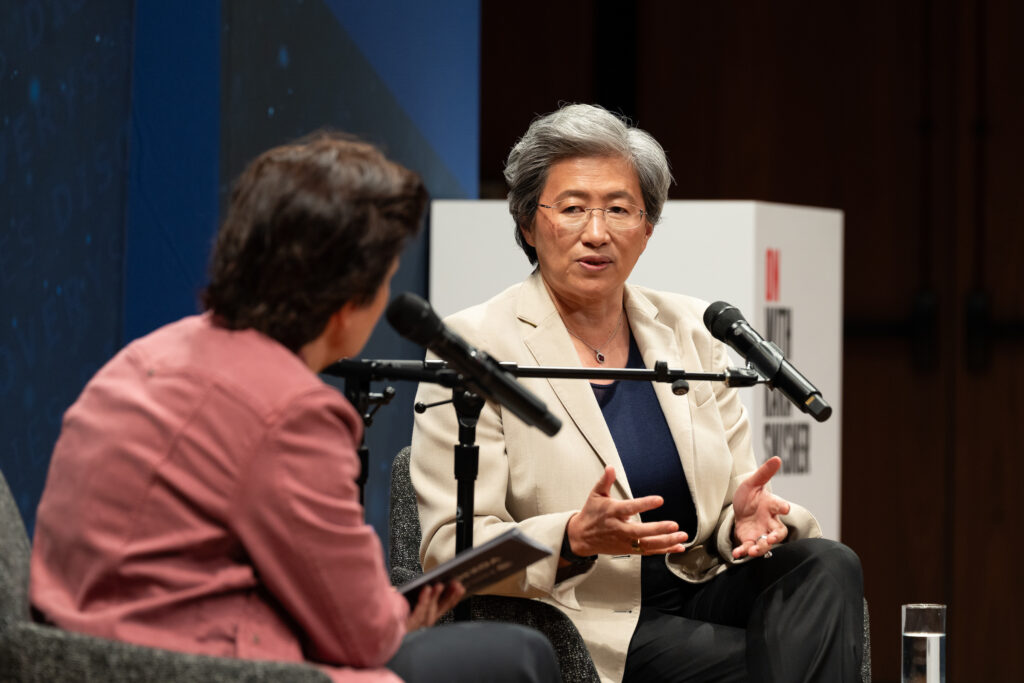AMD CEO: AI policy must encourage speed and innovation
Lisa Su explores the current state and future of AI, U.S.-based chip manufacturing

As someone with a front-row seat to the AI race, Lisa Su, CEO of Advanced Micro Devices (AMD), a company that designs and develops the chips behind AI advances, knows that in order to keep the U.S. competitive in the sector, her engineers must work on a timeline that has “negative slack.” Put simply: They must work faster than their runway.
“I say it’s negative slack is because the industry is moving so fast,” she said, speaking of the AI sector at a live podcast recording of On with Kara Swisher at the Hopkins Bloomberg Center. “I’ve just not seen an industry move this fast.”
The speed of innovation—and how it intersects with issues like tariffs and export controls—is top of mind for Su as her company navigates an industry that’s at the center of national security and tech innovation. Here are four things she’s seeing play out in AI and what she sees as critical to ensuring the U.S. remains ahead.
- The technology is changing quickly and is in its infancy
While DeepSeek, a Chinese AI app developed faster and at a significantly lower cost than previous models, shocked the world when it was released in early 2025, Su said it didn’t come as much of a surprise to her.
In fact, for Su, the fast rate of change in AI indicates that it is still in its infancy.
People are “genuinely impressed that you could reduce the cost of completing a task by a factor of 10 or a factor of 100 in a short amount of time,” she said. “That doesn’t happen often. That tells you that you’re still in the early stages.”
Su said in the next 10 years, she expects AI will be everywhere, from consumer devices to edge computing technology, and lead to major advances in life sciences.
- Policy should enable American innovators to move faster
Even with DeepSeek, the U.S. remains the leader in AI today, Su said. She added that keeping that edge requires policies that enable—not hinder—speed.
Su pointed to tariffs and export controls as policies that could slow companies down. Export controls, for example, are highly complex national security policies that require time to comply with. She said “protecting the crown jewels” is critical but so is ensuring American companies have the nimbleness and resources to compete.
“My main message, whether I’m talking about the company or the country, is let’s figure out how to run faster,” she said.
- Chip manufacturing is moving to the U.S.—but slowly
One thing that’s not happening fast: the shift to manufacture more semiconductors in the United States. Su said it can take several years and a strategic plan to transition this complex supply chain entirely into the U.S.
But, she said, early efforts to build more semiconductors at home are paying off. Previously, experts assumed that chips produced in the U.S. would not be of the same quality as those built elsewhere, but new semiconductors made in Arizona have challenged that notion. Taiwan Semiconductor Manufacturing Company Ltd. recently reported the chips it made in the Grand Canyon State are equivalent in terms of yield and quality to semiconductors manufactured in Taiwan.
“We see it in our own products,” Su said. “It’s fantastic.”
- University research accelerates innovation
Amid the Trump administration’s cuts of grant funding for research at universities, Su spoke about the importance of “non-commercial” research. With funding from the federal government, universities can conduct longer term research to investigate potential breakthroughs without the need for immediate payoff.
She added that university students accelerate the rate and pace of innovation.
“I’m a big believer in university research,” Su said. “I’m a big believer in the fact that research, especially [research] that is early on and not tied to commercial interests, is actually a great thing. So the government has been a big funder of that.”